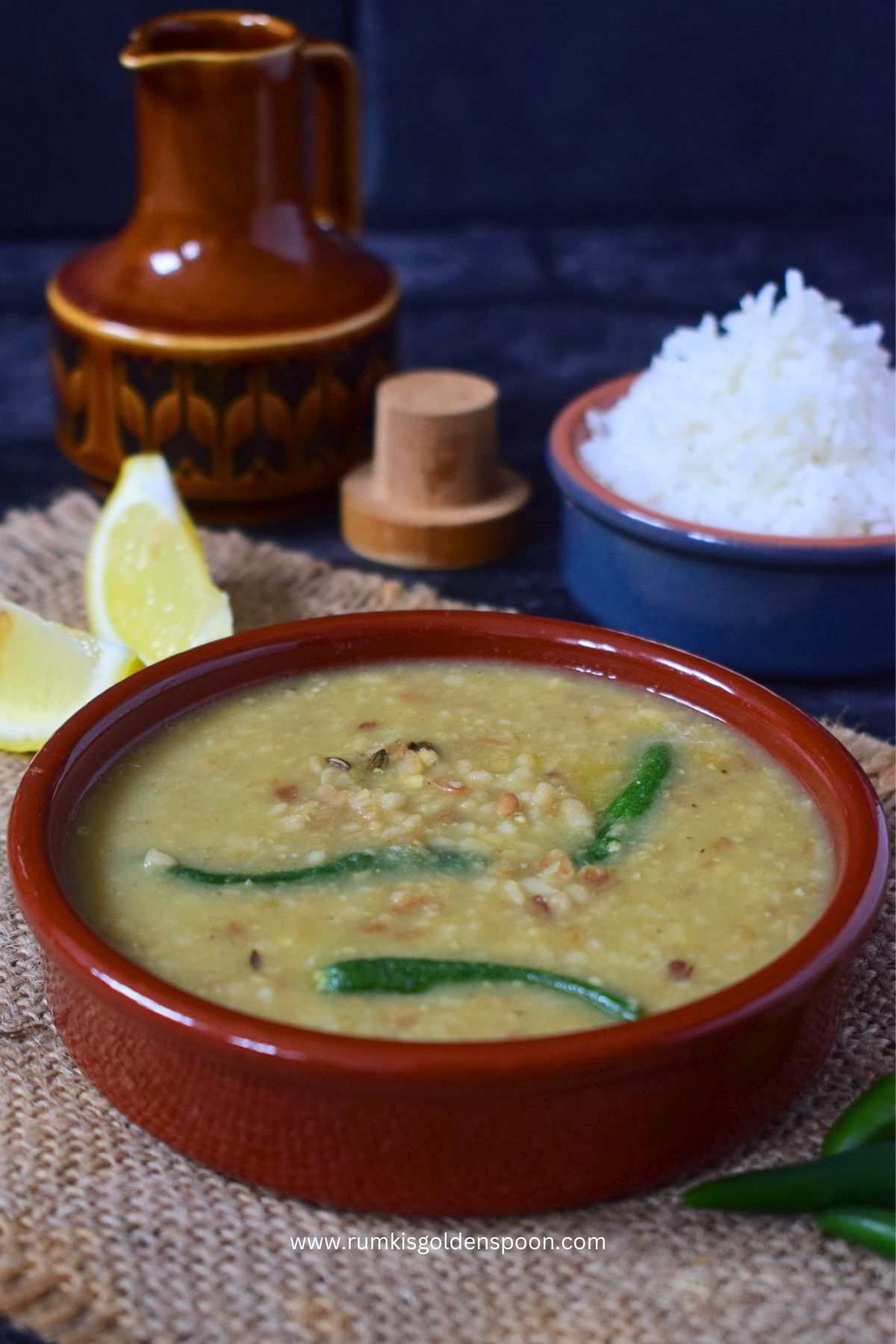Biulir dal recipe aka kolai dal is a classic Bengali dal recipe which is crazily popular among Bengalis. It is slightly thick in consistency and overloaded with flavours. It is a pure niramish recipe, I mean no onion no garlic recipe which is perfect for Bengali vegetarian days and puja days. In this preparation, biulir dal aka urad dal is dry roasted till aromatic and then boiled till al dente and then cooked with ginger-fennel seeds paste. It is an asset of Bengali cuisine which is frequently prepared in every Bengali household, especially during the summer season. This urad dal Bengali recipe is relished with plain rice along with aloo posto etc.
Dal aka lentils are the most common staples and a superb protein source in the Indian diet. There are myriad dal recipes prepared every day in each house in India. Whether it’s lunch or dinner, a bowl of comforting dal is always there on the dining table. This Bengali dal recipe is one of them.
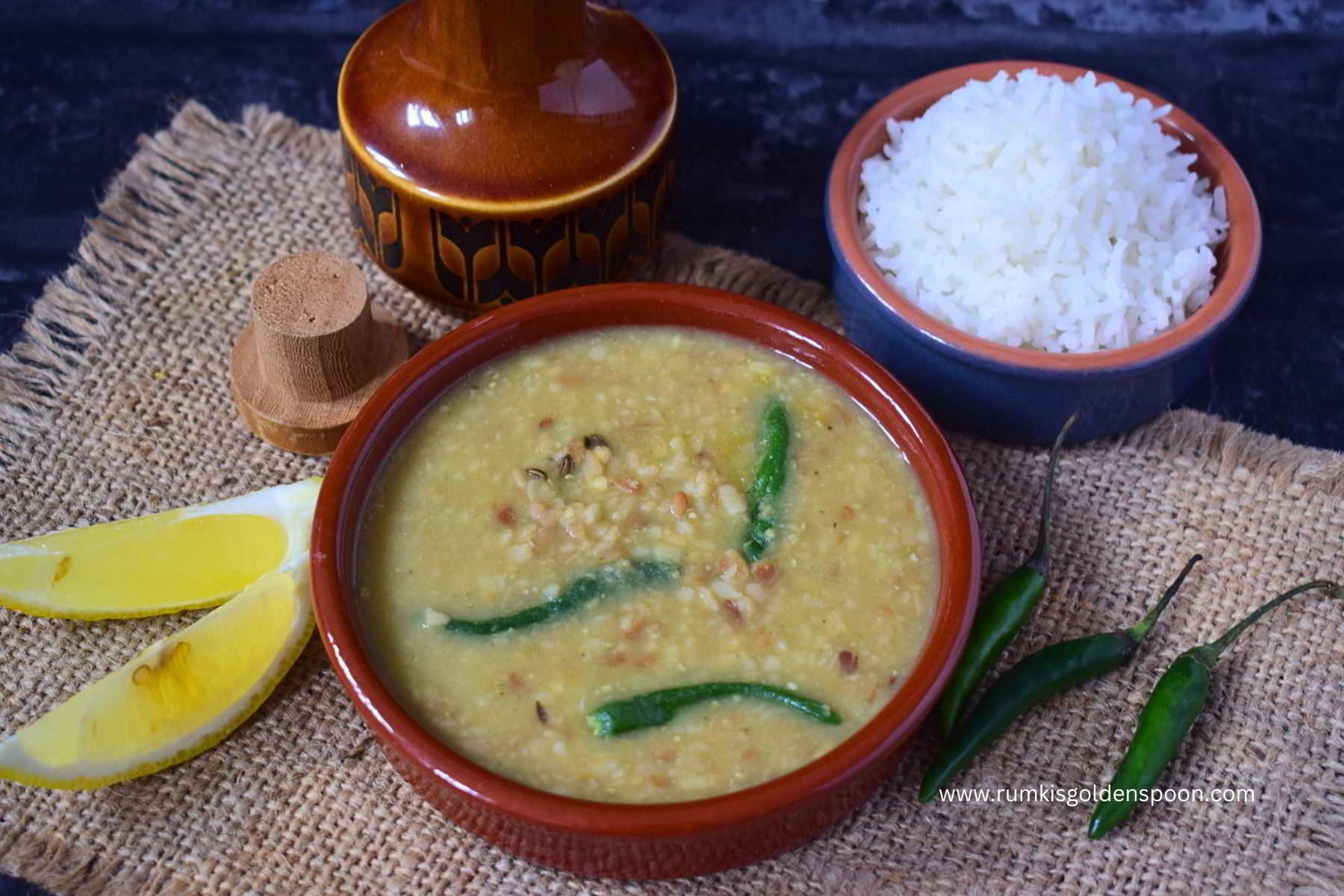
Table of Contents
About the recipe
Tips and Suggestions
Health Benefits of Urad Dal
How to make Biulir dal (step wise photos)
Recipe Card
What is Biulir dal?
Biulir dal is a traditional Bengali dal recipe which is frequently prepared in Bengali houses on regular days. According to many people, this dal helps us to keep our stomachs cool. So, it is pretty popular on hot days. Biulir dal is also referred to as kalaier dal in Bengali, urad dal in Hindi and split-skinned black gram in English.
Biulir dal recipe is mostly prepared in two different ways vegetarian and non-vegetarian. In a non-vegetarian way, it can be prepared adding fish heads.
In a vegetarian way, it can be prepared using ginger fennel seeds paste or using panch phoron and bay leaves. Both ways are popular but today I will share the first type with you.
Bengalis are scrupulous about vegetarian food and they split it into two different parts. One division is called satvik food where onion, garlic and even masoor dal are prohibited along with non-vegetarian items. In another division, normal vegetarian dishes are prepared using onion and garlic. Onion and garlic are considered rajasik food which produces heat in our body and inflames our passion and incomprehension. This biulir dal recipe belongs to satvik food because no onion-garlic is used.
Whenever I talk about kolaier dal, it always makes me feel nostalgic. As a bong, I have grown up eating this delicacy and have never gotten bored yet. I still remember how my mother used to prepare it on vegetarian days and puja days. She used to serve it mostly with plain rice, a slice of gondhoraj lebu and aloo posto for lunch and we used to devour that with immense pleasure. I have learned this Bengali dal recipe from her.
Kolai dal is a pure Bengali delicacy and you will get the essence of Bengal in it. It is a GHOTI special (people who originated from West Bengal) dal recipe. Ghoti people prefer to add a little bit of sugar into the dal but BANGAL people try to avoid sugar in the dal.
Biulir dal is a very simple and easy recipe. It requires very limited ingredients which are easily available in any Bengali kitchen pantry. The difficulty of preparing this dish is low. The best part of the recipe is that you don’t need to drop your tears for slicing onions. It could be a great option for no onion no garlic days.
Biulir dal ingredients
Biulir dal aka urad dal: The primary component of the recipe which provides body to the dal recipe.
Ginger & fennel seeds paste: It is another important ingredient to flavour up the dal recipe. I have made a paste using fresh peeled and roughly chopped ginger and fennel seeds.
Green chillies: The addition of green chillies adds a heaty taste and refreshing flavour to the dish.
Mustard oil: Always use mustard oil to cook the recipe like any other traditional Bengali food. It enhances the taste and flavour of the dish.
Whole spices & hing: I have added whole spices like dry red chillies, bay leaf and fennel seeds for tempering. Once the whole spices crackled, I have added hing to the pan. These spices induce a nice aroma into the oil. So, try not to skip any of these whole spices.
Ghee aka clarified butter: It is another important ingredient added at the final stage of cooking. The addition of ghee enhances the taste and flavour of the dal.
Sugar: It adds a mild sweetness to the dish and enhances the taste.
Salt: The most important ingredient which adds saltiness to the dish.
Water: Water is used to cook the biulir dal and to adjust the final consistency of the dal.
Biulir dal with step-by-step photos and instructions has been provided in the ‘Instruction’ section of the recipe. I have included all the tips and tricks below. If you follow each step of my recipe precisely then you will get Bengali urad dal with perfect flavour and consistency.
Tips to prepare perfect Biulir dal
- Dry roast the biulir dal aka urad dal over medium flame till slightly changes in colour and a nutty aroma comes out of it. Stir it continuously for even roasting.
- Boil the dal till al dente and not mushy for perfect texture.
- Always use mustard oil to cook the Bengali dal recipe. It gives a better flavour and taste to the dish.
- Don’t skip the whole spices from the recipe. It induces a nice aroma into the oil.
- Always prepare a fresh ginger-fennel paste for the dal. It gives a nice flavour to the dish. Don’t skip it.
- The addition of sugar is completely your own choice. If you don’t like then can skip it.
Health benefits of Urad Dal
- They are full of fibres which is great for our digestion. It helps to get rid of piles, constipation and works as a liver stimulant.
- Urad dal is a great source of potassium and magnesium which is beneficial for the health of our heart.
- They are full of minerals like calcium and Iron which help to strengthen our bones and nervous system.
- They are very good for our skin and hair.
How to make Biulir dal?
To prepare the biulir dal, first, take a dry pan and dry roast the urad dal over medium flame till a nutty aroma comes out and the colour of the dal changes to slightly pinkish. Stir it continuously. Then wash the dal in running water and drain the water.
Then transfer the dal into a pressure cooker. Add water and salt to it and stir it. Close the lid of the pressure cooker. Then cook it on medium flame until 4 whistles are completed. Allow the pressure cooker to release pressure. Then mash the dal a couple of times using dal ghutni or balloon whisk or potato masher or using the back of the spoon for better texture. But please don’t overdo or else the dal will turn to slurry.
I have used a pressure cooker to boil the dal. Whenever you run out of time pressure cooker always helps you to save time. But you can use kadai too to cook the dal. But it will take a little longer to get cooked as compared to the pressure cooker.
On the other hand, add some peeled diced ginger cubes and fennel seeds into a jar of a grinder. Add some water and close the lid. Pulse it to a smooth paste and keep it aside.
Now put a pan on flame and allow it to become completely dry. Add mustard oil to the pan. Once the oil is hot, add whole spices dry red chilli, bay leaf, fennel seeds and let them crackle. Turn the flame low, add hing aka asafoetida into the pan, and stir quickly.
Now, add the boiled dal to the pan and give a nice stir. Then add the ginger-fennel seeds paste, green chillies into the pan and mix it well. Add some water to the pan to adjust the consistency of the dal.
Cover the pan and cook it over a high flame until the dal starts boiling. Then turn the flame low and cook it for 5 more minutes.
At the final stage of cooking, add sugar, ghee (clarified butter) to the pan and mix it well. Check the salt of the dal and add if required. Simmer the gravy for 10-15 more seconds and then switch off the flame.
Many Bengali dal recipes have already been shared in my previous posts. You can check a few of them like
Bhaja moong dal
Cholar dal
Aam dal
Bengali matar dal
..And Many more…
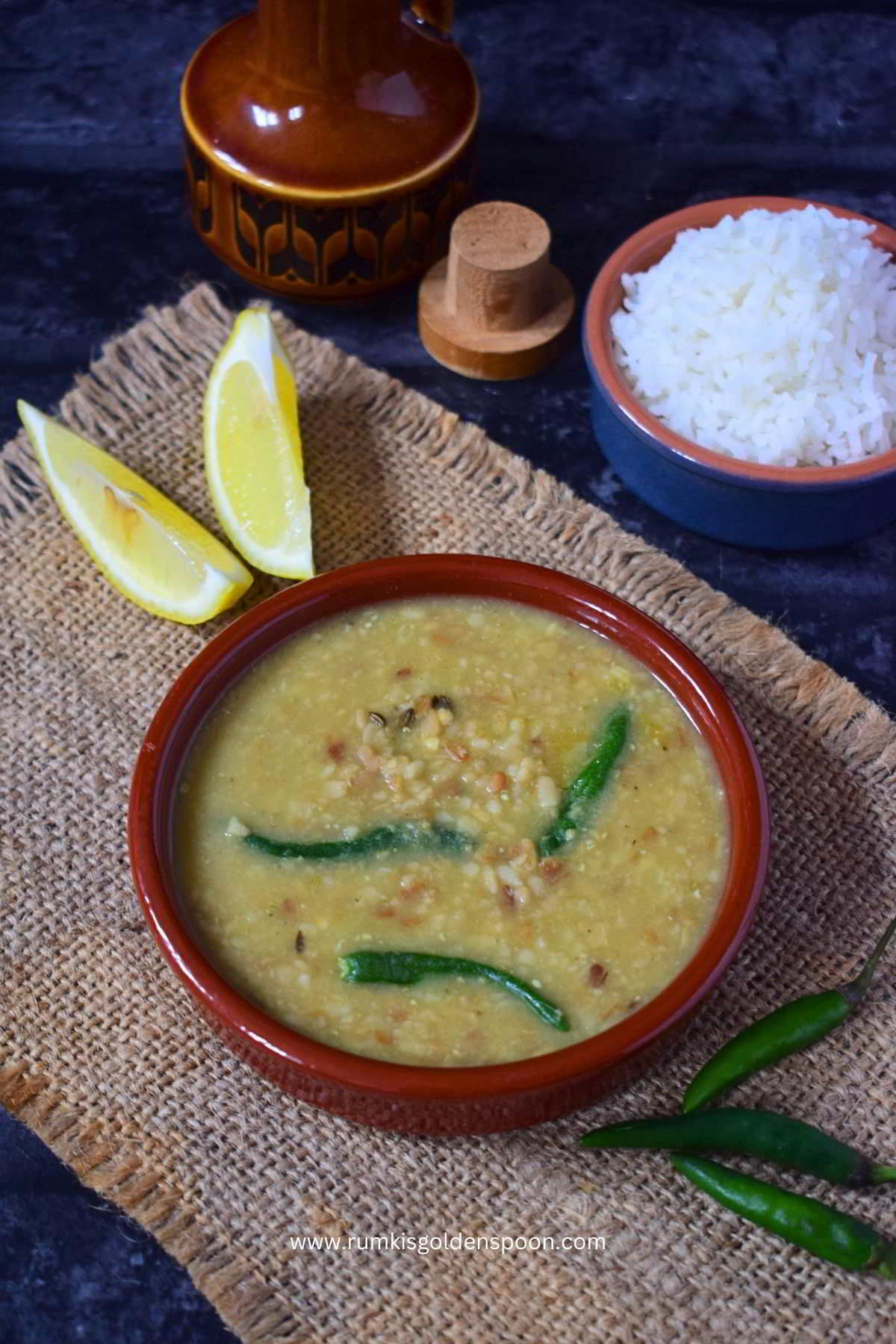
Ingredients:
1 cup = 250 ml
To cook the dal
- ½ cup Biulir dal aka Urad dal aka skinned split black gram
- 1½ cups Water
- 1 teaspoon Salt
For the ginger fennel paste
- 1 inch Ginger, peeled and diced
- 1 teaspoon Fennel seeds
- 2 tablespoons Water
Other ingredients for biulir dal
- 2-3 green Chillies
- 1 Bay leaf (Tejpatta)
- 1 -2 dry red Chillies (Sukhi lal mirch)
- ½ teaspoon Fennel seeds (Saunf)
- ¼ teaspoon Hing aka Asafoetida
- 1 teaspoon Sugar
- 1 teaspoon Ghee aka clarified Butter
- ½ cup Water to adjust the consistency
- Salt to taste
- 2 teaspoons Mustard oil
Instructions:
- First, take a dry pan and dry roast ½ cup urad dal over medium flame till a nutty aroma comes out and the colour of the dal changes to slightly pinkish. Stir it continuously.
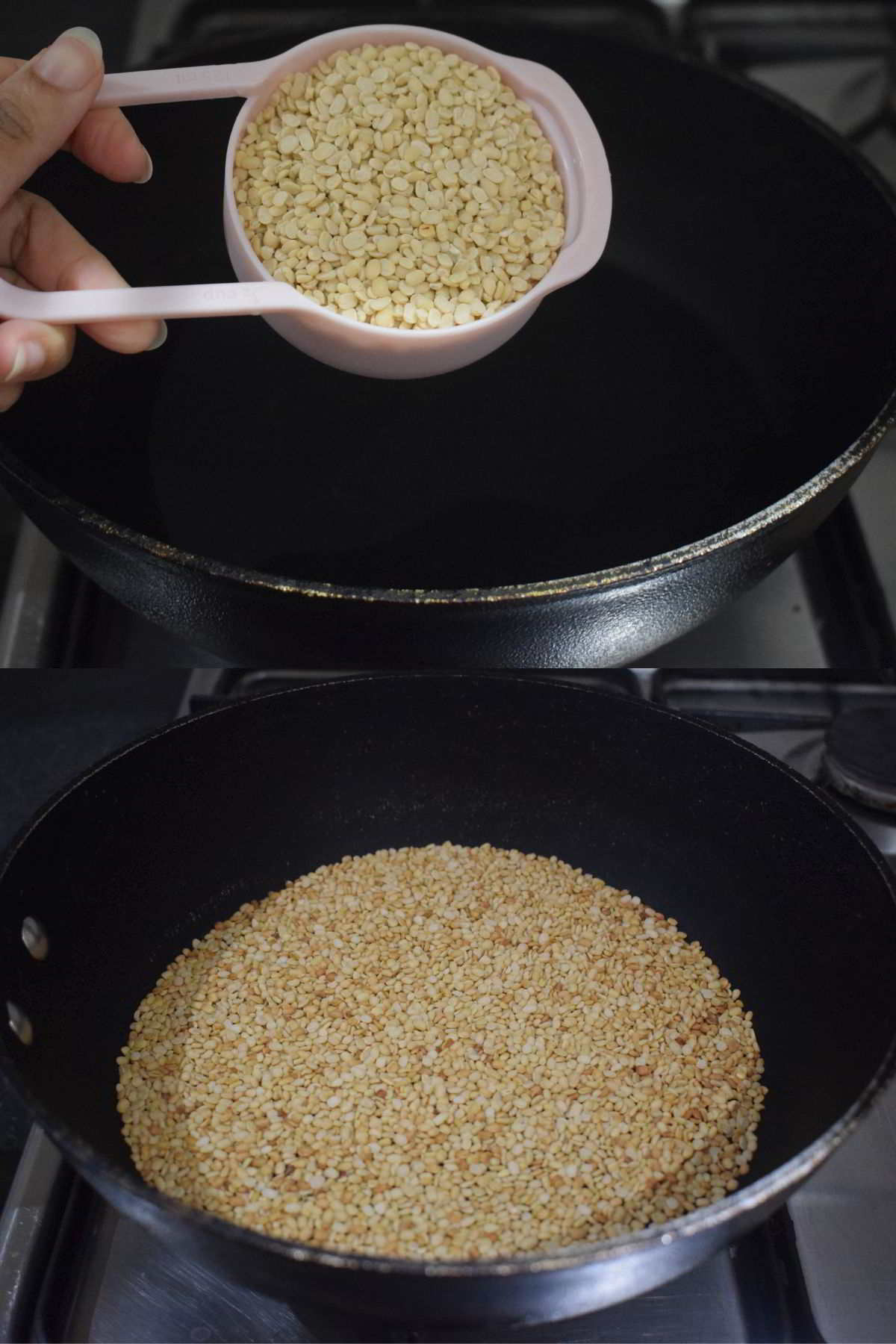
- Wash the dal in running water and drain the water. Then transfer the dal into a pressure cooker. Add 1½ cups water and 1 teaspoon salt into it and give a stir. Close the lid of the pressure cooker. Then cook it on medium flame until 4 whistles are completed.
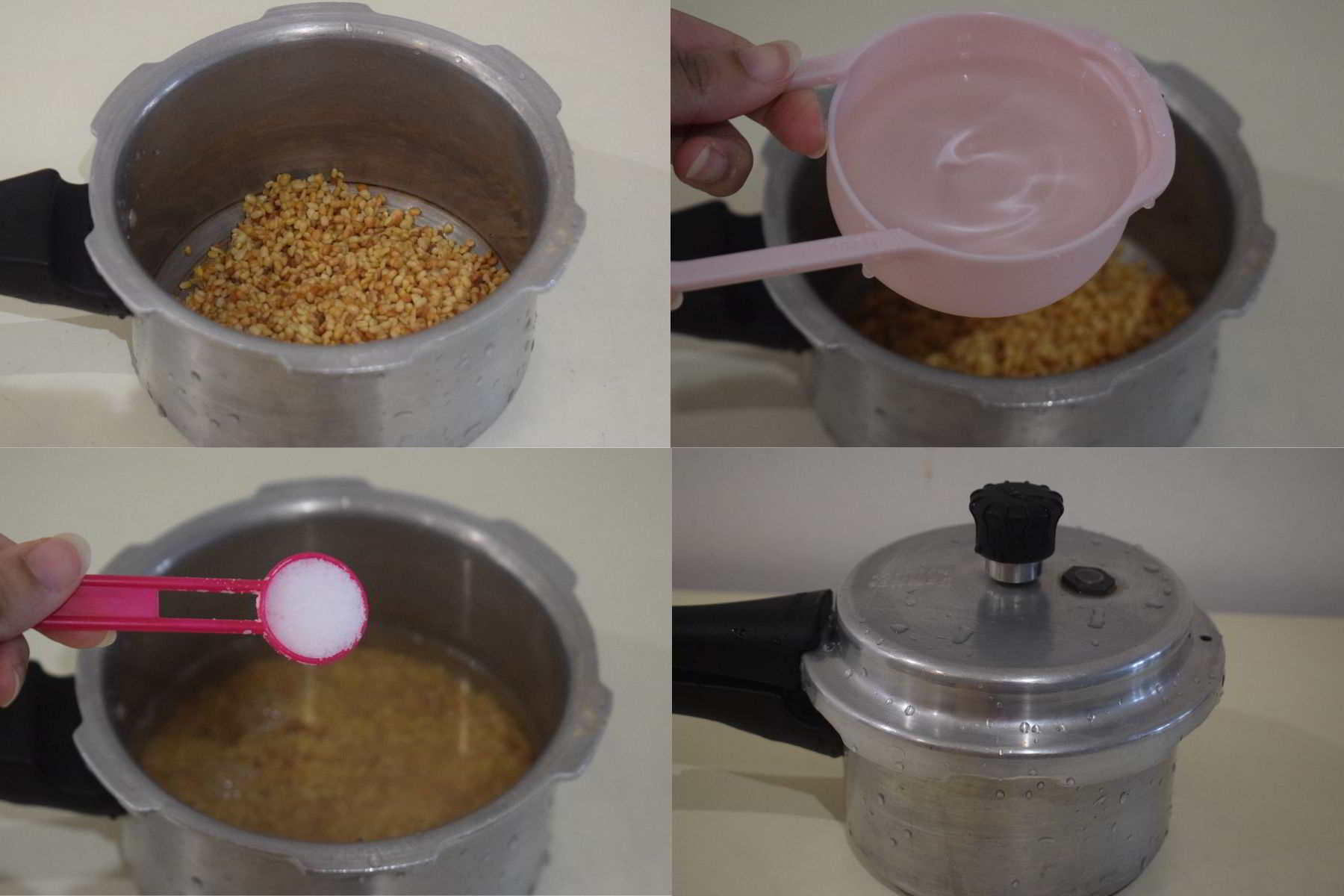
- Allow the pressure cooker to release pressure. Then mash the dal a couple of times using dal ghutni or balloon whisk or potato masher or using the back of the spoon for better texture. But please don’t overdo or else the dal will turn to slurry.
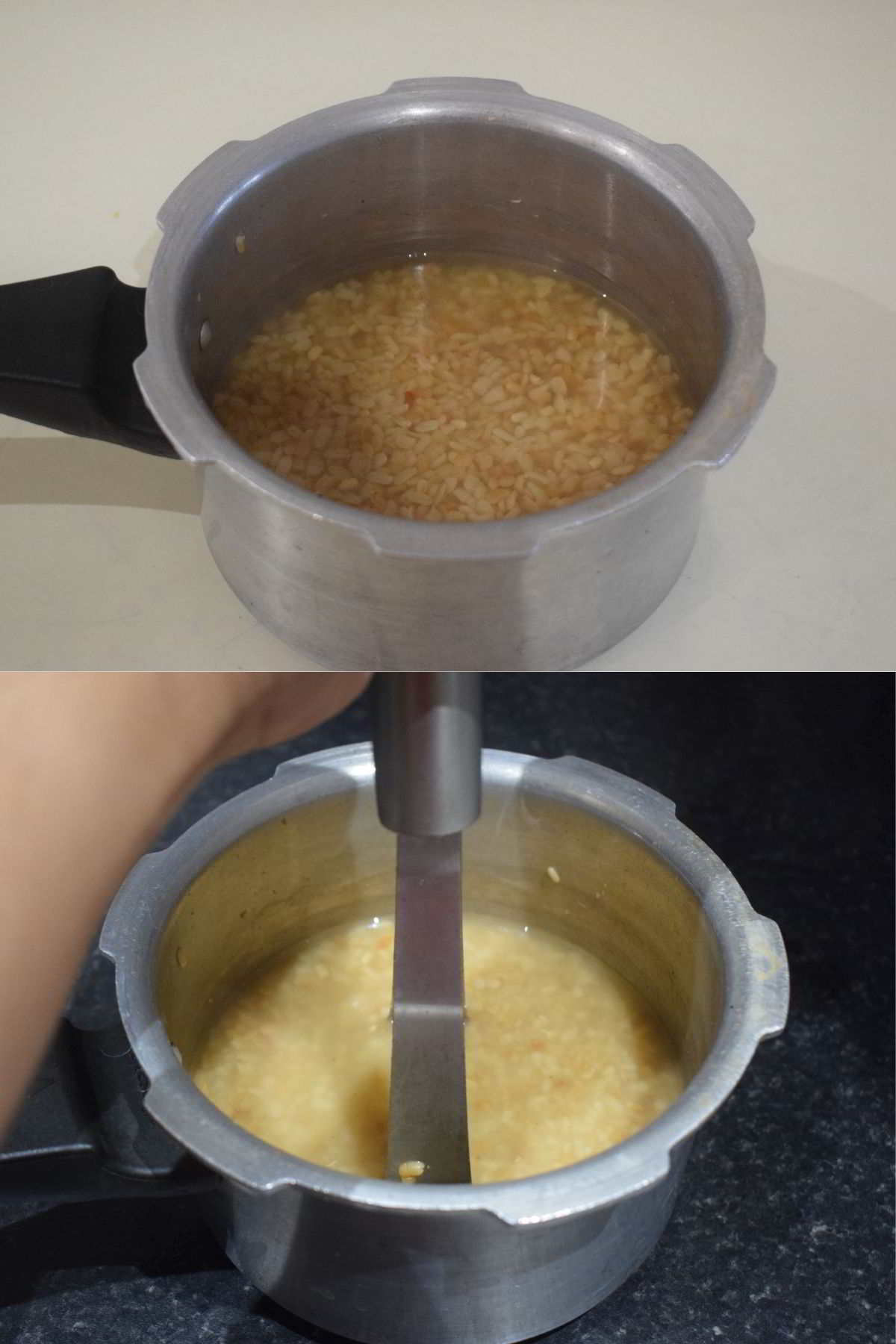
- On the other hand, add 1 inch of ginger peeled & diced into cubes, and 1 teaspoon of fennel seeds into a jar of a grinder. Add 2 tablespoons water and close the lid. Pulse it to a smooth paste and keep it aside.
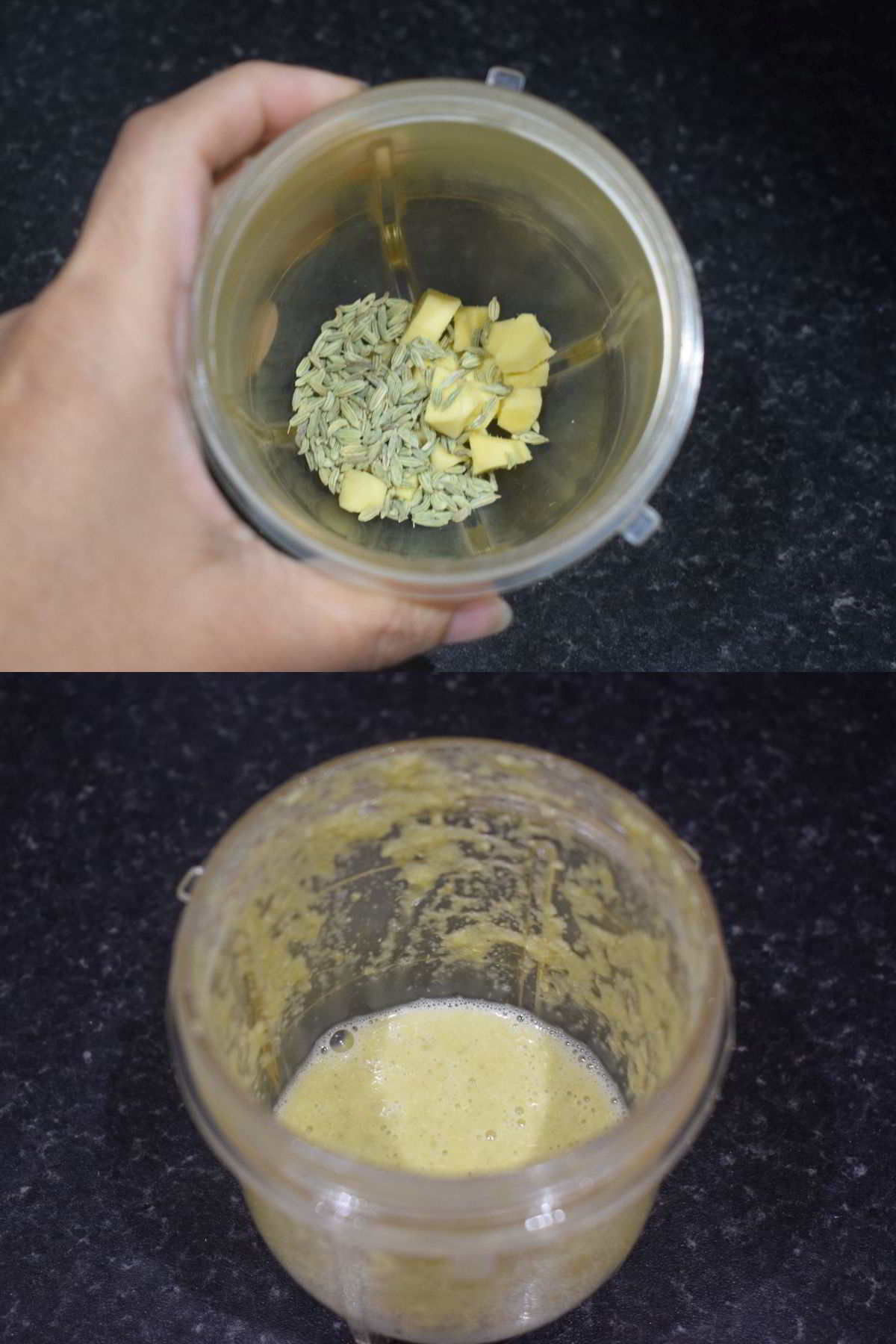
- Now put a pan on flame and allow it to become completely dry. Add 2 teaspoons of mustard oil to the pan.
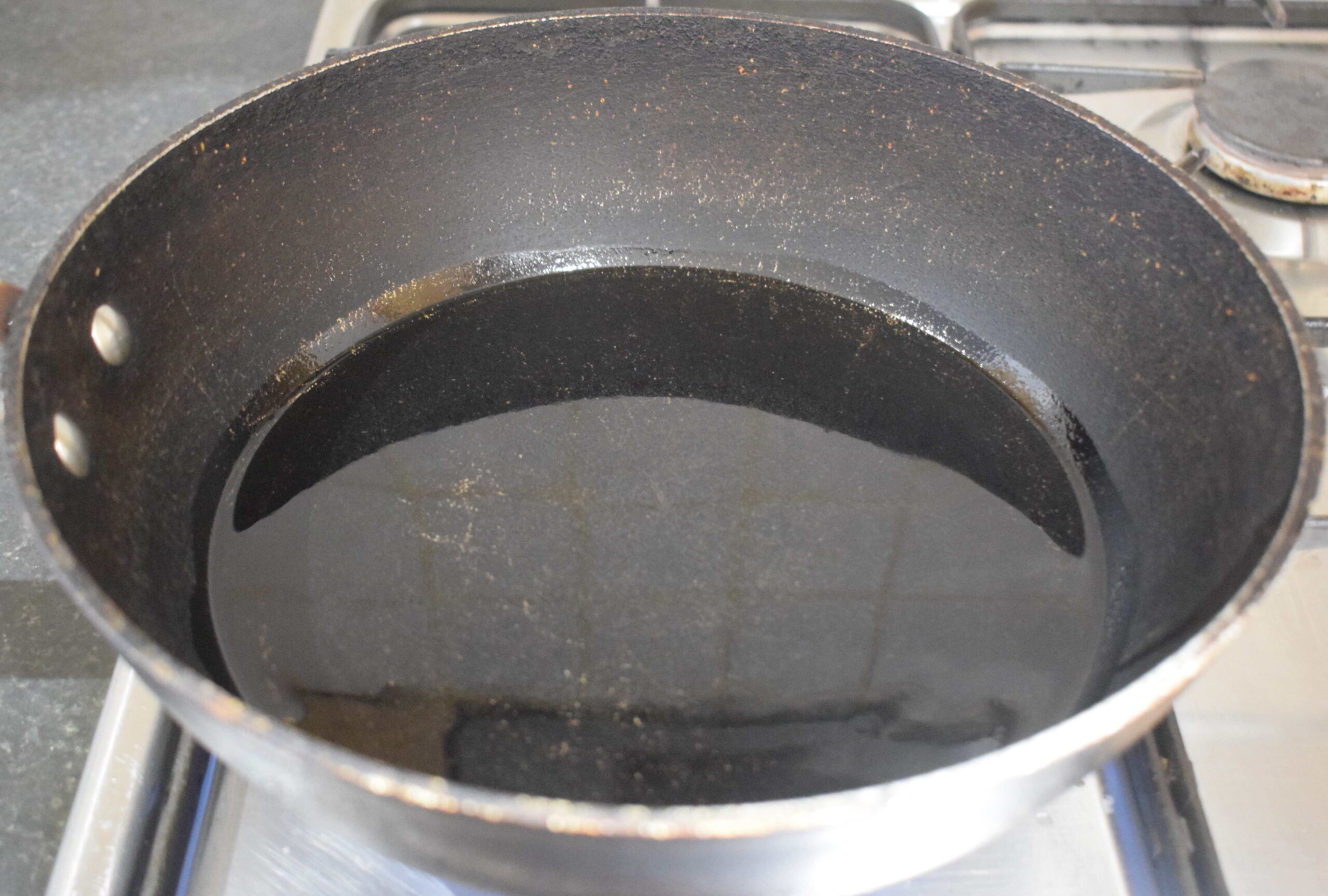
- Once the oil is hot, add whole spices 1-2 dry red chillies, 1 bay leaf, ½ teaspoon fennel seeds and let them crackle. Turn the flame low, add ¼ teaspoon hing aka asafoetida into the pan, and stir quickly.
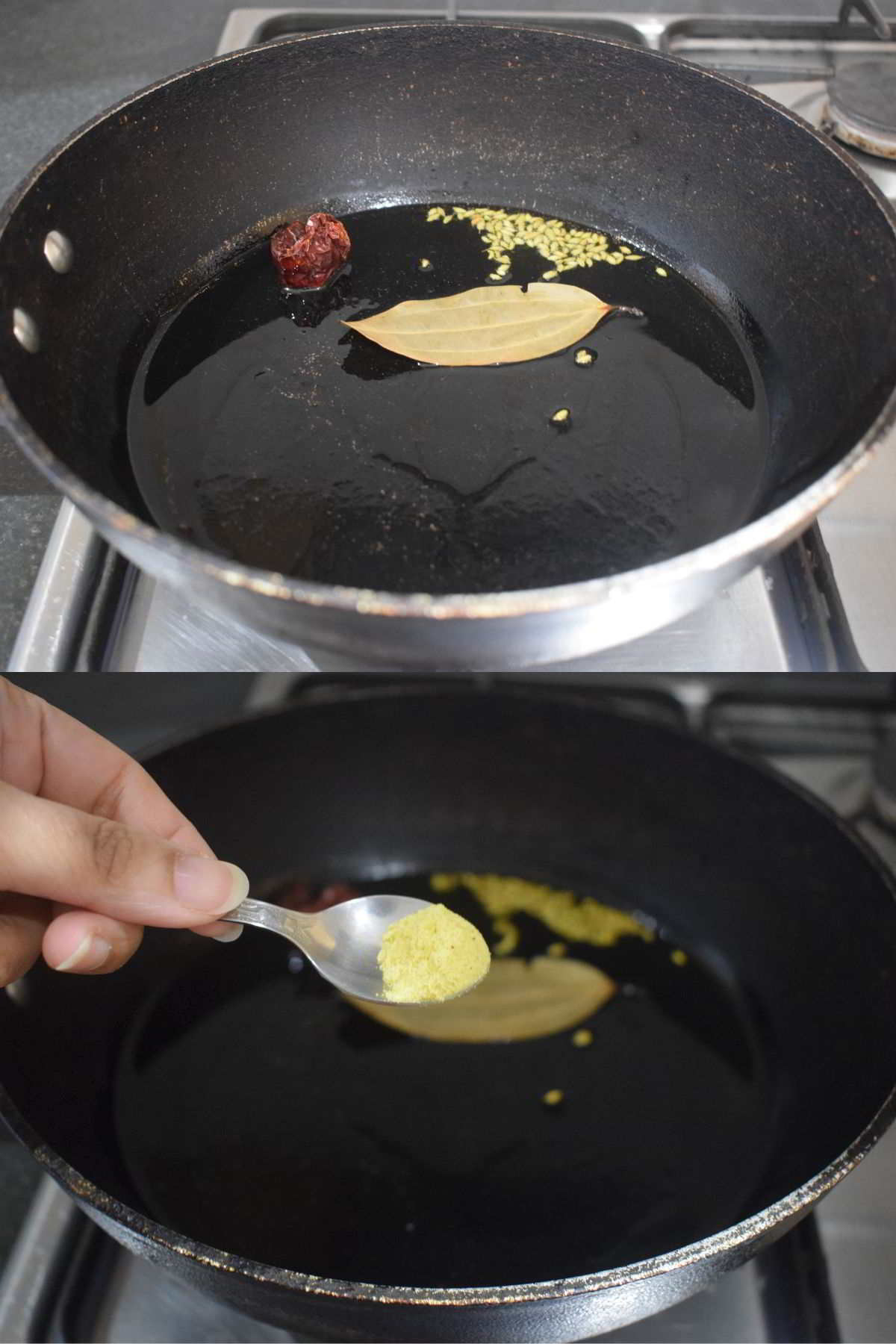
- Now add the boiled dal (Step 3) into the pan and give a nice stir.
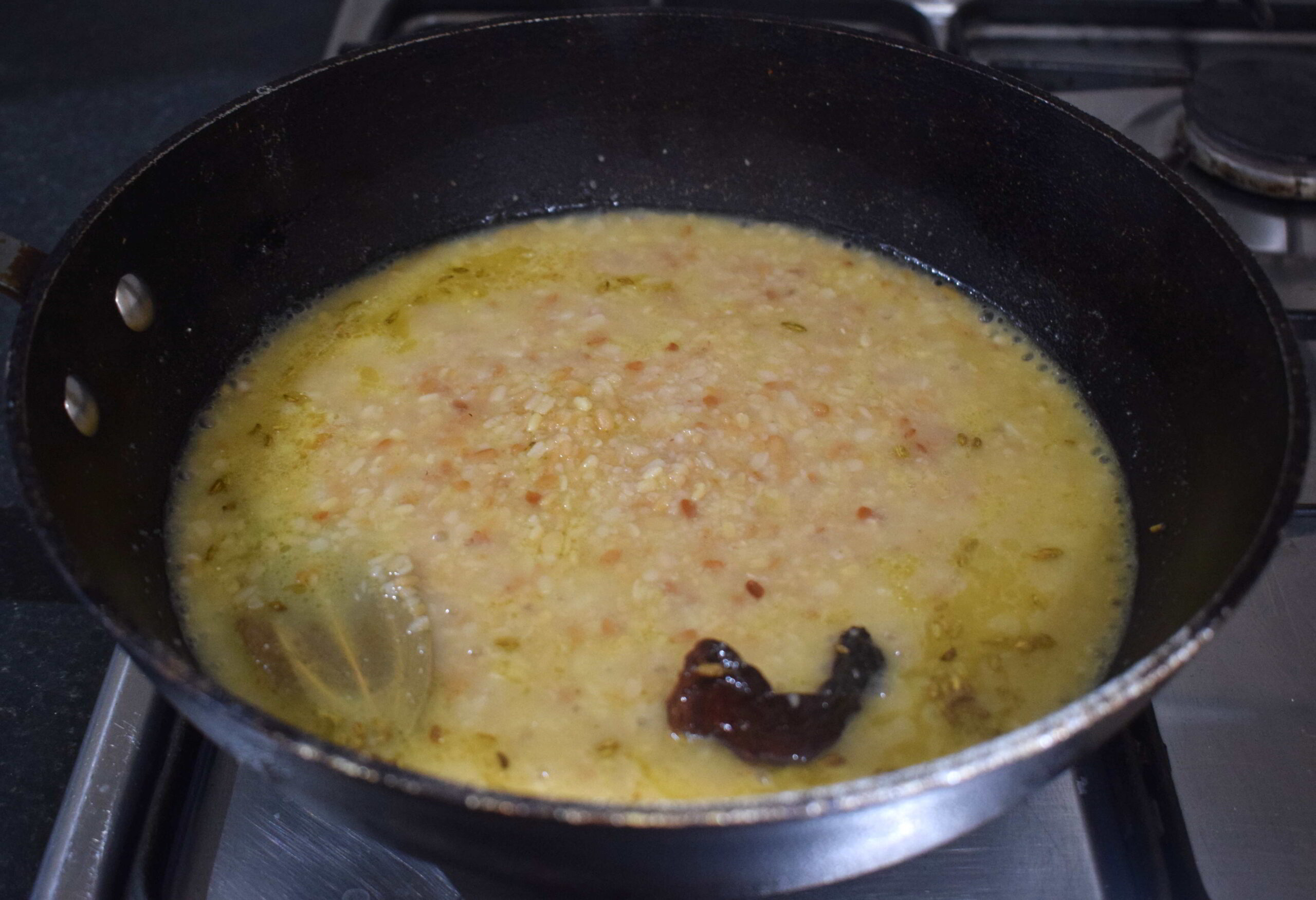
- Add the ginger-fennel seeds paste (Step 4), 2-3 green chillies into the pan and mix it well.
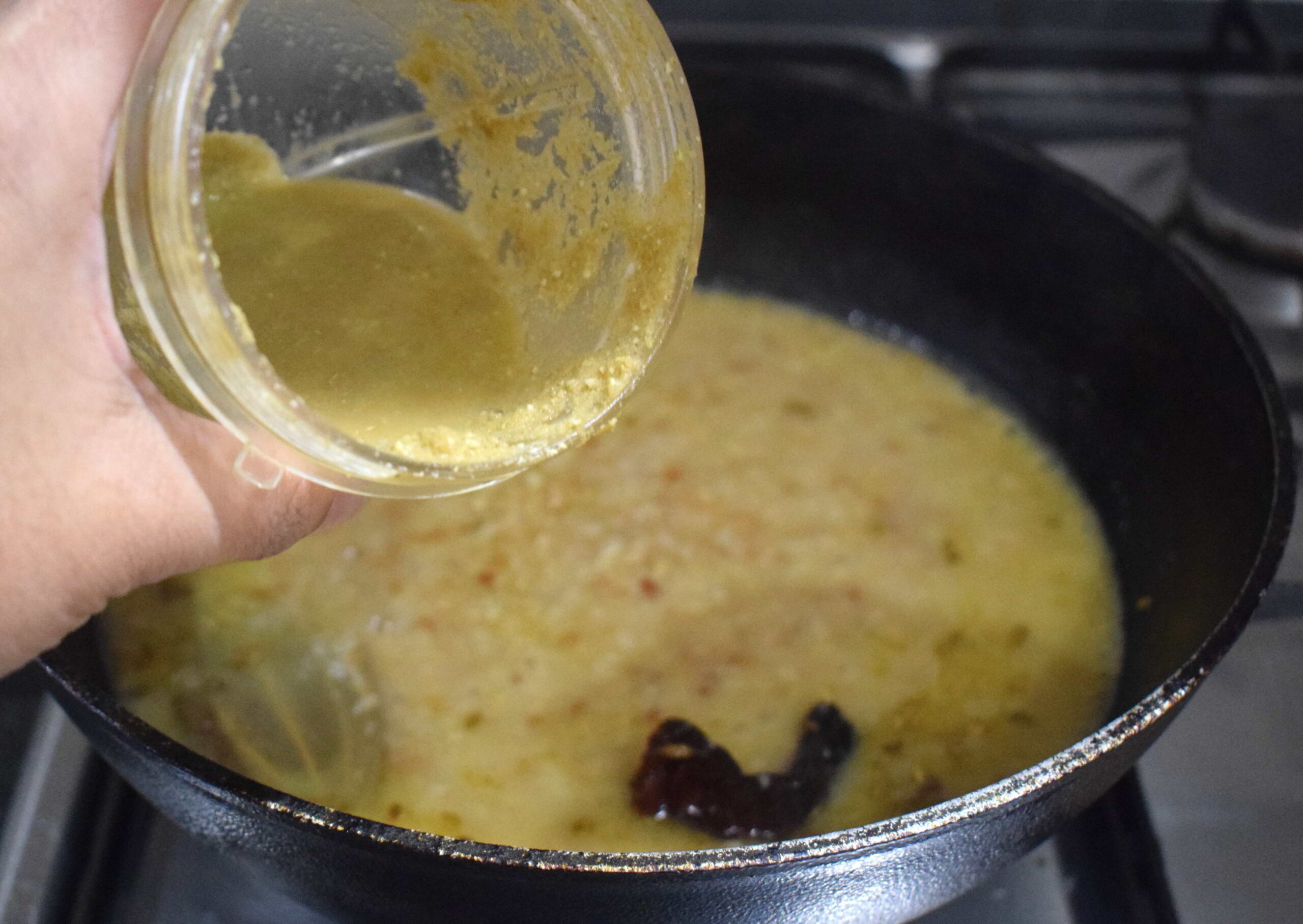
- Add ½ cup water into the pan to adjust the consistency of the dal.
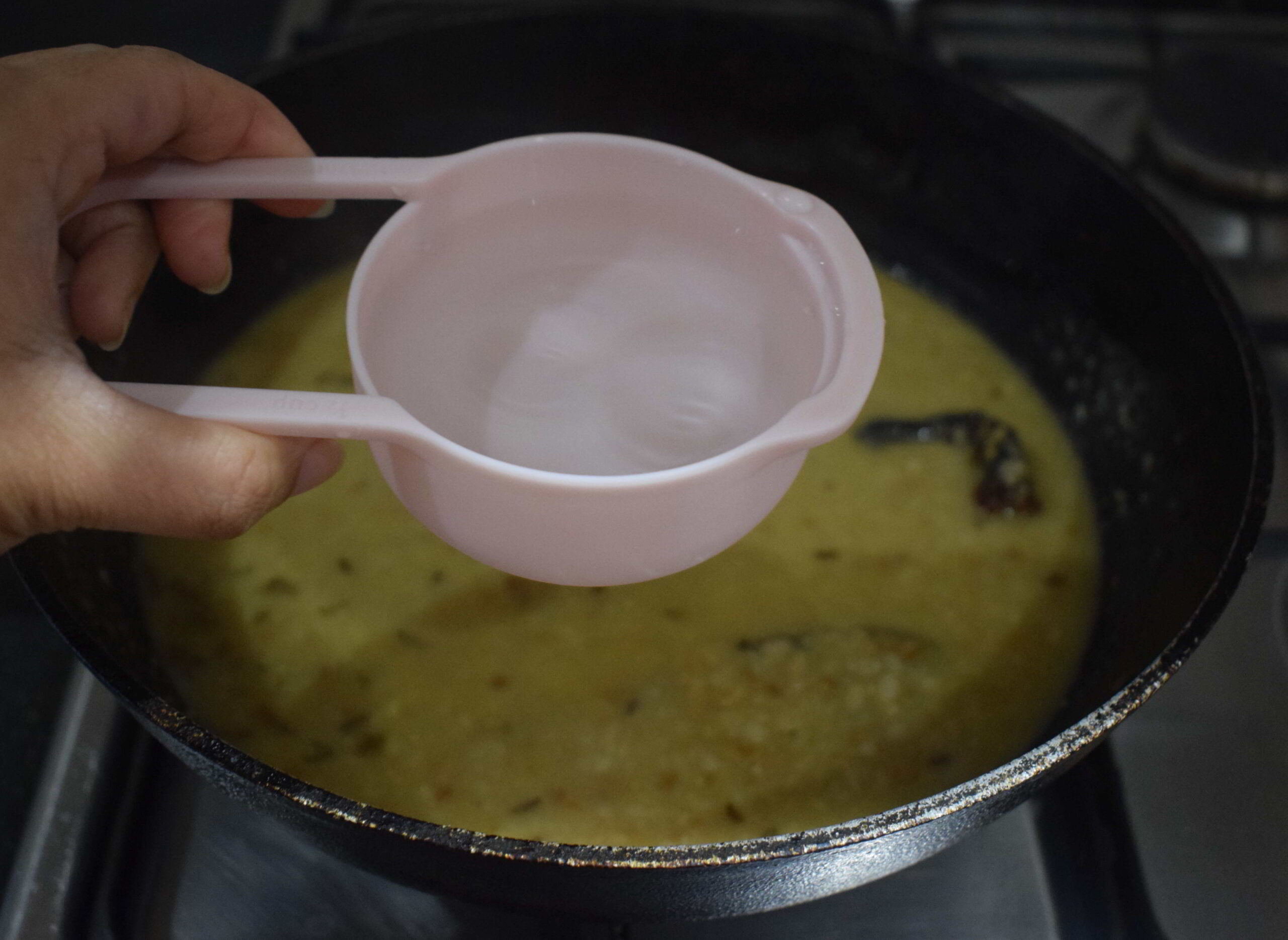
- Cover the pan and cook it over a high flame until the dal starts boiling. Then turn the flame low and cook it for 5 more minutes.
- At the final stage of cooking, add 1 teaspoon sugar, 1 teaspoon ghee (Clarified butter) to the pan and mix it well.
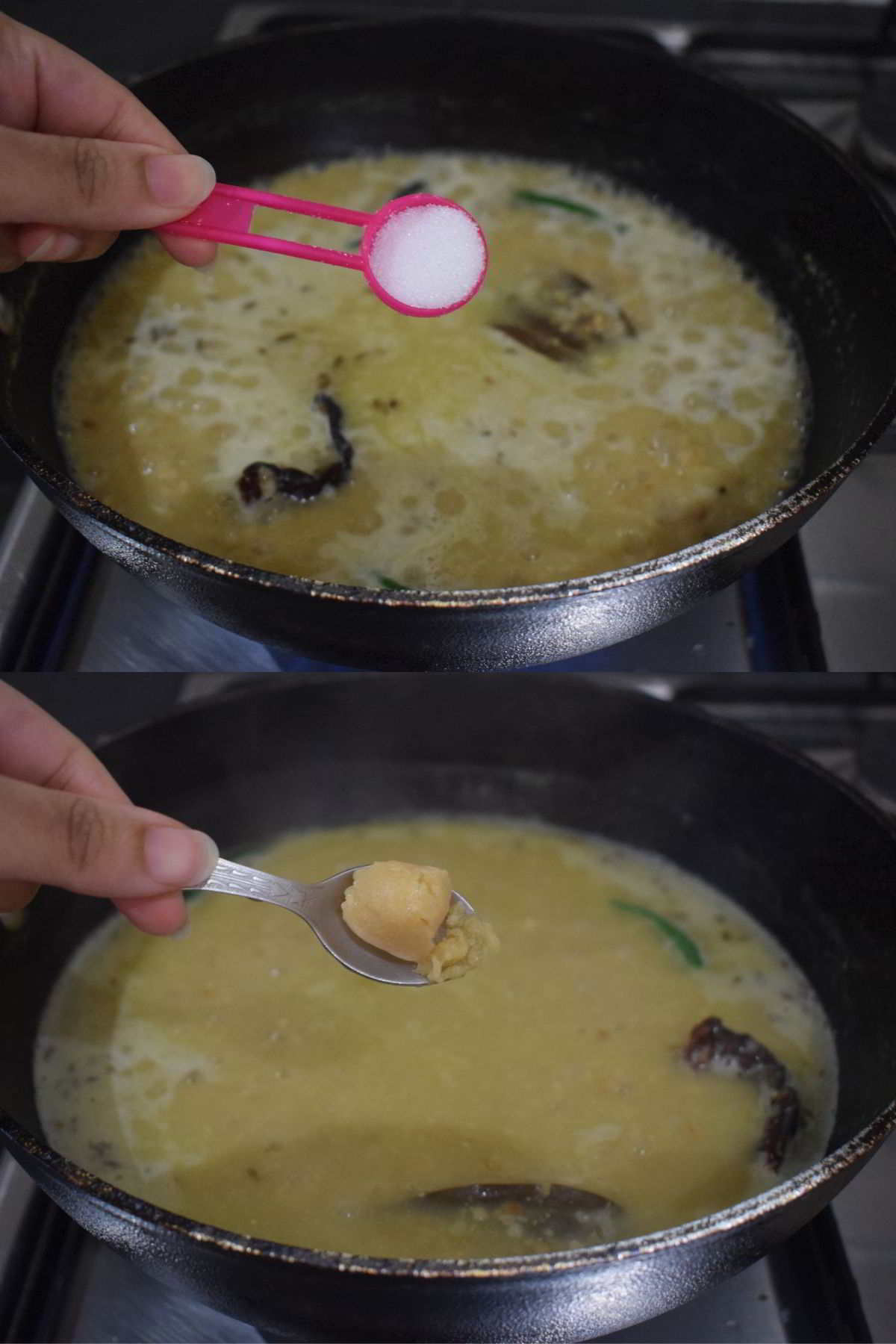
- Check the salt of the dal and add if required. Simmer the gravy for 10-15 more seconds and then switch off the flame.
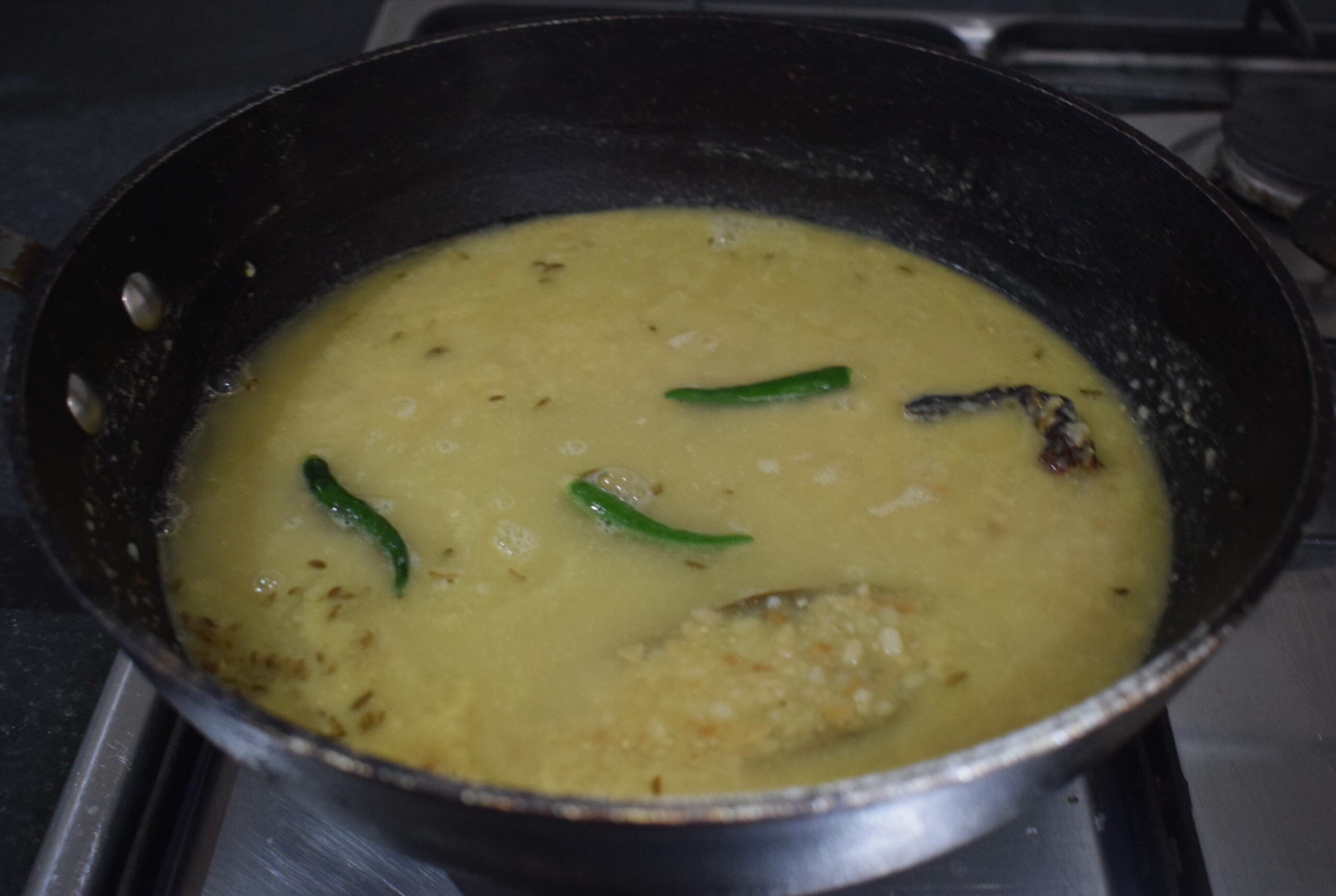
Serving Instruction
Transfer the biulir dal into a serving bowl or on a serving plate. Serve hot or warm to enjoy its best taste. Pair up the comforting dal with plain hot rice with aloo posto or aloo bhate.
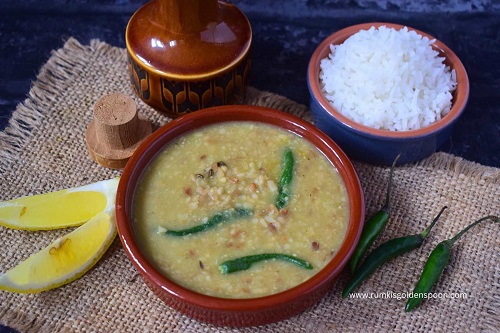
Ingredients
1 cup = 250 ml
To cook the dal
- ½ cup Biulir dal aka Urad dal aka skinned split black gram
- 1½ cups Water
- 1 teaspoon Salt
For the ginger fennel paste
- 1 inch Ginger, peeled and diced
- 1 teaspoon Fennel seeds
- 2 tablespoons Water
Other ingredients for biulir dal
- 2-3 green Chillies
- 1 Bay leaf (Tejpatta)
- 1 -2 dry red Chillies (Sukhi lal mirch)
- ½ teaspoon Fennel seeds (Saunf)
- ¼ teaspoon Hing aka Asafoetida
- 1 teaspoon Sugar
- 1 teaspoon Ghee aka clarified Butter
- ½ cup Water to adjust the consistency
- Salt to taste
- 2 teaspoons Mustard oil
Instructions
- First, take a dry pan and dry roast ½ cup urad dal over medium flame till a nutty aroma comes out and the colour of the dal changes to slightly pinkish. Stir it continuously.
- Wash the dal in running water and drain the water. Then transfer the dal into a pressure cooker. Add 1½ cups water and 1 teaspoon salt into it and give a stir. Close the lid of the pressure cooker. Then cook it on medium flame until 4 whistles are completed.
- Allow the pressure cooker to release pressure. Then mash the dal a couple of times using dal ghutni or balloon whisk or potato masher or using the back of the spoon for better texture. But please don’t overdo or else the dal will turn to slurry.
- On the other hand, add 1 inch of ginger peeled & diced into cubes, and 1 teaspoon of fennel seeds into a jar of a grinder. Add 2 tablespoons water and close the lid. Pulse it to a smooth paste and keep it aside.
- Now put a pan on flame and allow it to become completely dry. Add 2 teaspoons of mustard oil to the pan.
- Once the oil is hot, add whole spices 1-2 dry red chillies, 1 bay leaf, ½ teaspoon fennel seeds and let them crackle. Turn the flame low, add ¼ teaspoon hing aka asafoetida into the pan, and stir quickly.
- Now add the boiled dal (Step 3) into the pan and give a nice stir.
- Add the ginger-fennel seeds paste (Step 4), 2-3 green chillies into the pan and mix it well.
- Add ½ cup water into the pan to adjust the consistency of the dal.
- Cover the pan and cook it over a high flame until the dal starts boiling. Then turn the flame low and cook it for 5 more minutes.
- At the final stage of cooking, add 1 teaspoon sugar, 1 teaspoon ghee (Clarified butter) to the pan and mix it well.
- Check the salt of the dal and add if required. Simmer the gravy for 10-15 more seconds and then switch off the flame.

